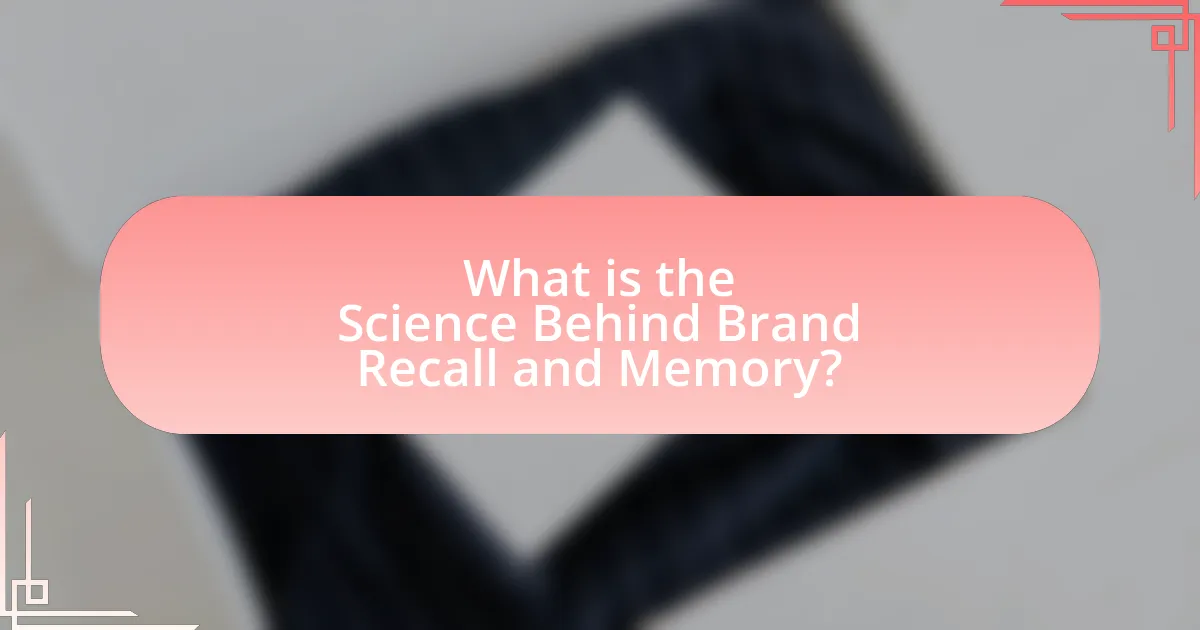The article explores the science behind brand recall and memory, emphasizing the cognitive processes that enable consumers to recognize and remember brands. Key factors influencing brand recall include familiarity, emotional connections, and the distinctiveness of brand elements. The article discusses how brand recall affects consumer behavior, loyalty, and advertising effectiveness, highlighting the psychological processes involved, such as recognition and association. Additionally, it examines strategies for enhancing brand recall, including consistent branding, emotional storytelling, and the use of user-generated content, providing practical tips for brands to improve their recall and memory strategies.

What is the Science Behind Brand Recall and Memory?
The science behind brand recall and memory involves cognitive processes that enable consumers to recognize and remember brands. Brand recall is influenced by factors such as familiarity, emotional connection, and the distinctiveness of brand elements. Research indicates that repeated exposure to a brand enhances familiarity, which in turn increases the likelihood of recall; for instance, a study published in the Journal of Consumer Research found that brands with higher advertising frequency are more easily remembered by consumers. Additionally, emotional connections formed through storytelling or impactful advertising can create stronger memory traces, making brands more memorable. The brain’s encoding and retrieval processes play crucial roles, where effective brand associations can lead to improved recall during decision-making.
How do brand recall and memory influence consumer behavior?
Brand recall and memory significantly influence consumer behavior by determining how easily consumers can retrieve a brand from memory when making purchasing decisions. High brand recall leads to increased likelihood of brand choice, as consumers tend to favor brands they remember over unfamiliar options. Research indicates that brands with strong recall can capture up to 70% of market share in their category, demonstrating the direct correlation between memory and consumer preference. Additionally, memory influences emotional connections to brands, which can enhance loyalty and repeat purchases, as consumers are more likely to choose brands that evoke positive memories or associations.
What psychological processes are involved in brand recall?
Brand recall involves several psychological processes, primarily recognition, retrieval, and association. Recognition occurs when consumers identify a brand from memory, while retrieval refers to the ability to access stored information about the brand. Association plays a crucial role, as it links the brand to specific attributes, experiences, or emotions, enhancing memory retention. Research indicates that strong brand associations can significantly improve recall; for instance, a study by Keller (1993) in the Journal of Consumer Research found that brands with well-established associations are more easily recalled by consumers. This demonstrates that the interplay of recognition, retrieval, and association is fundamental to effective brand recall.
How does memory retention affect brand loyalty?
Memory retention significantly influences brand loyalty by enhancing consumers’ ability to recall and recognize a brand when making purchasing decisions. When consumers retain positive memories associated with a brand, such as favorable experiences or effective marketing messages, they are more likely to develop a preference for that brand over competitors. Research indicates that brands with strong memory retention can achieve a 20% increase in customer loyalty, as consumers are more inclined to repurchase from brands they remember positively. This correlation between memory retention and brand loyalty underscores the importance of effective branding strategies that foster memorable experiences and associations.
Why is understanding brand recall important for marketers?
Understanding brand recall is crucial for marketers because it directly influences consumer purchasing decisions. When consumers can easily remember a brand, they are more likely to choose it over competitors, leading to increased sales and brand loyalty. Research indicates that brands with higher recall rates enjoy a significant advantage; for instance, a study by Nielsen found that 59% of consumers prefer to buy new products from brands they are familiar with. This highlights the importance of effective marketing strategies that enhance brand recall, ensuring that a brand remains top-of-mind during the decision-making process.
What role does brand recall play in advertising effectiveness?
Brand recall significantly enhances advertising effectiveness by ensuring that consumers can easily remember and recognize a brand when making purchasing decisions. High brand recall leads to increased brand preference and loyalty, as consumers are more likely to choose familiar brands over unfamiliar ones. Research indicates that brands with strong recall can achieve up to 80% higher sales compared to those with weak recall, demonstrating the direct correlation between recall and consumer behavior. This effectiveness is rooted in cognitive psychology, where repeated exposure to a brand reinforces memory pathways, making it easier for consumers to retrieve brand information when needed.
How can brands measure recall among their target audience?
Brands can measure recall among their target audience through surveys and focus groups that assess brand recognition and memory retention. These methods allow brands to directly ask consumers about their awareness of specific products or advertisements, providing quantitative data on recall rates. For instance, a study published in the Journal of Advertising Research found that using aided and unaided recall tests can effectively gauge how well consumers remember a brand after exposure to marketing efforts. By analyzing the responses, brands can determine the effectiveness of their campaigns and make data-driven adjustments to enhance recall.

What factors affect Brand Recall and Memory?
Brand recall and memory are influenced by several key factors, including brand familiarity, emotional connection, and the distinctiveness of the brand. Brand familiarity enhances recall as consumers are more likely to remember brands they have encountered frequently; studies show that repeated exposure increases recognition and retrieval. Emotional connection plays a crucial role, as brands that evoke strong feelings are more memorable; research indicates that emotional advertising can increase brand recall by up to 23%. Lastly, distinctiveness, such as unique logos or slogans, aids memory retention; brands that stand out in a crowded marketplace are more easily recalled, supported by findings that suggest distinctive elements can improve recall rates significantly.
How do emotional connections impact brand recall?
Emotional connections significantly enhance brand recall by creating stronger associations in memory. When consumers experience emotions tied to a brand, such as joy or nostalgia, these feelings activate neural pathways that facilitate easier retrieval of brand information. Research indicates that emotionally charged advertisements can increase brand recall by up to 23 times compared to neutral ads, as demonstrated in a study published in the Journal of Advertising Research. This heightened recall occurs because emotions engage the amygdala, which plays a crucial role in processing emotional experiences and memory formation, thereby making the brand more memorable.
What types of emotions are most effective in enhancing recall?
Positive emotions, particularly joy and surprise, are most effective in enhancing recall. Research indicates that emotionally charged experiences, especially those that evoke happiness or unexpectedness, significantly improve memory retention. For instance, a study published in the journal “Emotion” by researchers at the University of California found that participants who experienced positive emotions during learning tasks had a 20% higher recall rate compared to those who did not. This demonstrates that emotions like joy and surprise create stronger neural connections, facilitating better memory retrieval.
How does storytelling influence memory retention for brands?
Storytelling significantly enhances memory retention for brands by creating emotional connections and engaging narratives that are easier for consumers to remember. Research indicates that stories activate multiple areas of the brain, including those responsible for emotions and sensory experiences, which helps encode information more effectively. For instance, a study published in the journal “Neuroscience” found that narratives can increase information retention by up to 22 times compared to non-narrative formats. This heightened engagement leads to stronger brand recall, as consumers are more likely to remember brands associated with compelling stories.
What role does repetition play in brand memory?
Repetition significantly enhances brand memory by reinforcing brand recognition and recall. When consumers are repeatedly exposed to a brand, the likelihood of them remembering it increases due to the mere exposure effect, which suggests that familiarity leads to preference. Research indicates that repeated advertising can improve brand recall by up to 80%, as demonstrated in studies by the Journal of Advertising Research, which found that consistent messaging over time solidifies brand associations in consumers’ minds. This process occurs because repetition strengthens neural pathways related to the brand, making it easier for consumers to retrieve brand information when making purchasing decisions.
How does frequency of exposure affect brand recall?
Frequency of exposure significantly enhances brand recall. Research indicates that repeated exposure to a brand increases familiarity, which in turn strengthens memory retention. A study by the Journal of Consumer Research found that consumers are more likely to remember brands they have encountered multiple times compared to those they have seen only once. This phenomenon is often attributed to the mere exposure effect, where individuals develop a preference for things merely because they are familiar with them. Thus, higher frequency of exposure leads to improved brand recall through increased familiarity and cognitive ease.
What are the diminishing returns of repeated brand exposure?
Repeated brand exposure leads to diminishing returns as consumers become desensitized to the brand message over time. Initially, increased exposure enhances brand recall and recognition, but after a certain point, additional exposure yields minimal incremental benefits. Research indicates that the effectiveness of advertising decreases after repeated viewings, with studies showing that consumers may experience ad fatigue, leading to negative perceptions of the brand. For instance, a study published in the Journal of Advertising Research found that after a certain frequency of exposure, the likelihood of consumers recalling the brand declines, demonstrating the principle of diminishing returns in advertising effectiveness.

How can brands enhance their recall and memory strategies?
Brands can enhance their recall and memory strategies by utilizing consistent branding elements, emotional storytelling, and repetition. Consistent branding, such as logos, colors, and taglines, creates familiarity, which aids memory retention; studies show that consistent brand presentation can increase brand recognition by up to 80%. Emotional storytelling engages consumers on a deeper level, making the brand more memorable; research indicates that emotionally charged content is 22 times more memorable than factual information alone. Additionally, repetition reinforces memory; the mere exposure effect suggests that repeated exposure to a brand can significantly increase consumer preference and recall.
What techniques can brands use to improve recall?
Brands can improve recall by utilizing techniques such as consistent branding, emotional storytelling, and sensory engagement. Consistent branding reinforces recognition through repeated exposure to logos, colors, and messaging, which has been shown to enhance memory retention. Emotional storytelling creates a connection with consumers, making the brand more memorable; studies indicate that emotionally charged content is remembered more effectively than neutral content. Sensory engagement, such as incorporating sound or scent, can trigger memories associated with the brand, as research demonstrates that multisensory experiences significantly boost recall rates.
How does visual branding contribute to memory retention?
Visual branding significantly enhances memory retention by creating distinct and recognizable visual elements that facilitate recall. Research indicates that visuals are processed 60,000 times faster than text, making them more effective in capturing attention and embedding information in memory. For instance, a study published in the Journal of Consumer Research found that brands with strong visual identities are more likely to be remembered by consumers, as these visuals create associations that aid in retrieval. This connection between visual stimuli and memory is further supported by the dual coding theory, which posits that information is better retained when it is encoded both visually and verbally.
What are the best practices for creating memorable brand experiences?
The best practices for creating memorable brand experiences include delivering consistent messaging, engaging emotionally with consumers, and providing unique, immersive interactions. Consistent messaging reinforces brand identity, as studies show that brands with coherent narratives are 22 times more likely to be remembered. Emotional engagement is crucial; research indicates that emotionally connected customers have a 306% higher lifetime value. Unique experiences, such as personalized marketing or interactive events, enhance recall by creating lasting impressions, supported by findings that experiential marketing can increase brand recall by up to 70%.
How can brands leverage social media for better recall?
Brands can leverage social media for better recall by creating engaging, consistent content that resonates with their target audience. Engaging content, such as interactive posts, videos, and user-generated content, increases the likelihood of sharing and interaction, which enhances brand visibility. Consistency in messaging and visual identity across platforms reinforces brand recognition, as studies show that repeated exposure to a brand increases familiarity and recall. For instance, a study published in the Journal of Advertising Research found that consistent brand messaging can improve recall by up to 80%. By utilizing analytics to understand audience preferences and optimizing content accordingly, brands can further enhance their recall effectiveness on social media.
What strategies can be employed on social media to enhance brand memory?
To enhance brand memory on social media, brands can employ strategies such as consistent visual branding, storytelling, and user-generated content. Consistent visual branding, including logos and color schemes, helps create a recognizable identity that users can easily recall. Research indicates that visual elements can increase brand recognition by up to 80%. Storytelling engages audiences emotionally, making the brand more memorable; studies show that narratives can improve recall by 22 times compared to facts alone. Additionally, user-generated content fosters community and authenticity, leading to a 79% increase in brand engagement, which reinforces memory through repeated exposure.
How does user-generated content impact brand recall?
User-generated content significantly enhances brand recall by creating authentic connections between consumers and brands. This type of content, such as reviews, testimonials, and social media posts, fosters trust and relatability, making brands more memorable. Research indicates that 79% of consumers say user-generated content highly impacts their purchasing decisions, demonstrating its effectiveness in reinforcing brand identity and recall. Additionally, user-generated content often leads to increased engagement, which further solidifies brand presence in consumers’ minds.
What are practical tips for improving brand recall?
To improve brand recall, companies should focus on creating memorable and consistent brand experiences. Utilizing distinctive visual elements, such as logos and color schemes, enhances recognition; studies show that consistent branding can increase revenue by up to 23%. Engaging storytelling that resonates emotionally with the audience also aids memory retention, as narratives are easier to remember than facts alone. Additionally, frequent and varied touchpoints across multiple channels reinforce brand presence, making it more likely for consumers to recall the brand when making purchasing decisions.


